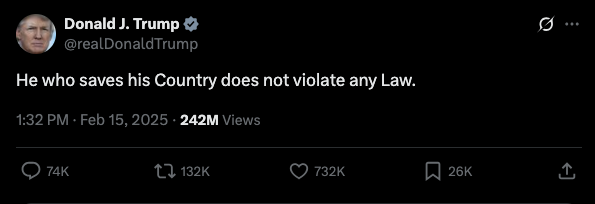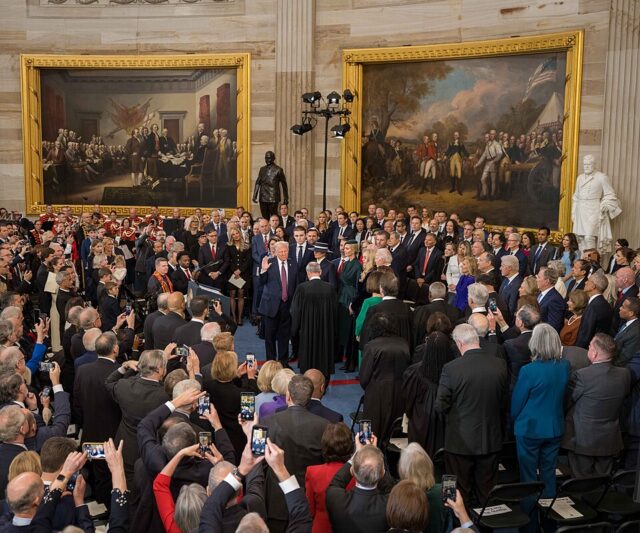The Tech: Elon Musk, Curtis Yarvin, Peter Thiel & Silicon Valley
This is not, of course, to characterize JD Vance as the ultimate mastermind behind a fascist takeover of the United States, nor to imply that there is in fact a single mastermind. Instead, we can see Vance as perhaps one central node in a web of individuals who each bring their various ideas and implementations into the administration.
Directly upstream from Vance, we see the unmistakable influence of billionaire Peter Thiel. Vance first encountered Thiel while a law student, and quickly fell into the orbit of the Silicon Valley billionaire. Beginning as funder of tech start-up projects, Thiel has made a habit of collecting politicians and sponsoring projects outside of the tech world which advance his right-wing vision. He was an early backer of Vance’s 2022 Senate run, who, along with failed Arizona candidate Blake Masters, represented a concerted push by Thiel to get his acolytes into the halls of power.
Thiel is well known in the alt-right, or “New Right,” world. Podcasters, entrepreneurs, electoral hopefuls and others who share his views talk openly of their hope to secure “Thielbucks.” Despite initially identifying as a libertarian, in 2009 Thiel stated he no longer believed freedom and democracy to be “compatible.” While continuing to use the “libertarian” label, Thiel has embraced ideas which seem at odds with his stated belief in “authentic human freedom as a precondition for the highest good.” Thiel biographer Max Chafkin has described his subject’s ideology as “combin[ing] an obsession with technological progress with nationalist politics—a politics that at times has seemingly flirted with white supremacy.”
Of course, no summary of the various Silicon Valley extremists who have their hand in shaping the second Trump administration would be complete without discussing Elon Musk. By far the most visible and remarked upon newcomer to the MAGA movement, Musk brought his own ideologies and views—heavily layered with cringe-worthy references to meme-culture—to this administration.
The richest man in the world was involved in financing the Trump-Vance campaign, and in return was named to head up the newly-established “Department of Governmental Efficiency,” or “DOGE.” Musk’s influence over that policy initiative was clear simply by the “agency’s” name: a reference to “Dogecoin,” a cryptocurrency named for an old meme. Soon after Trump’s inauguration, Musk and DOGE got busy with an all-out assault on the administrative state.
In many ways, these ideas are inherently self-serving. It is no coincidence that Elon Musk, a man whose various business interests have been subjected to a bevy of investigations for violations of federal laws ranging from the National Labor Relations Act to antitrust law, would seek to dismantle the regulatory state. Yet crass personal pecuniary interest alone cannot fully explain the current moment or Musk’s role in it. Musk may be a grifter, but he does claim to be motivated by certain ideologies, and his actions bear at least some of that out.
It has been much-hypothesized that Musk’s hard “anti-woke” turn was motivated by his reaction to his daughter coming out as trans. Regardless, Musk has clearly long held views that put him in alignment with this new strain of conservatism, and has taken steps to move closer to the far right. He’s backed Germany’s neo-nazi AfD party, calling them “the best hope for Germany,” and urging them to “move beyond” a “focus on past guilt.” And of course, there was Musk’s infamous hitlergruß moment, when he proudly displayed not one, but two Nazi salutes at Trump’s inauguration.
Musk is also a “pronatalist,” claiming that low birth rates are “a bigger risk to civilization than global warming.” Musk has certainly done his part, siring fourteen children with multiple women. Despite stated altruistic motives, many have seen a darkside to the pronatalist movement, which appears to put it into alignment with other right-wing ideologies. It has been described as inherently anti-feminist in its tendency to insist that women must focus on child bearing and rearing above all else.
Pronatalism also dovetails neatly with eugenicist views on the far right. The true problem that pronatalists see in the world may not truly be declining birth rates; it’s just that the wrong people are procreating. Thus, tech elites like Musk see it as their duty to fill the world with their clearly superior progeny, with a dog-whistle ideology that mirrors the white supremacist Great Replacement Theory.
Regardless of the reasons for Elon Musk’s decision to get more involved in far right politics, the impact of his ideology has been clear. He purchased Twitter in 2021, quickly transforming the social media platform into a cesspit of right-wing hate through changes to content moderation policies. He funded Donald Trump’s 2024 campaign to the tune of over a quarter of a million dollars. And of course, there’s his aforementioned work heading up DOGE.
In the end, Elon Musk remains a tech bro at his core. He is obsessed with disruption. That was the driving force behind his Twitter acquisition, and it is now at the heart of his agenda in Washington through DOGE. But while Musk may be the public face leading the charge, many of the ideas he’s implementing come out of someone else’s playbook.

Peter Thiel and Elon Musk.
Invariably, there is one thinker who has been cited and referenced by all of these above-mentioned men as a formative influence on their thinking. The “philosopher of Silicon Valley,” Curtis Yarvin has been cited by Vance, Thiel, Musk, and many other tech elites as a formative influence.
Curtis Yarvin and The “Dark Enlightenment”
Yarvin is considered one of the founders of the “Dark Enlightenment,” or “neo-reactionary movement” as it is sometimes called. Writing under the name “Mencius Moldberg,” Yarvin expanded upon the work of earlier writers and introduced these ideas to Silicon Valley. Central to his ideology is a rejection of liberal egalitarianism and a recognition of what Yarvin sees as “tremendous inborn differences between people…and between groups of people.”
Writing as Moldberg in what he later described as “a spirit of ‘open inquiry,’” Yarvin engaged in protracted ponderings on such subjects as racialized IQ variations. Many of his early writings spend page after page detailing supposed “scientific” racial variations and discussing their implications for society.
For instance, Yarvin in 2009 claimed the Civil Rights movement produced “absolute human garbage” as it granted “privilege” to “populations with recent hunter-gatherer ancestry and no great reputation for sturdy moral fiber.” He’s argued that Black people were happier under slavery, that women had it “pretty good” prior to the suffrage movement, and praised proposals to deport Muslims and close mosques. In claiming not to personally be a white supremacist, Yarvin still concedes that he’s “not exactly allergic to the stuff.”

Curtis Yarvin.
Neo-reactionaries like Yarvin tout openly anti-democratic views. They believe that freedom and democracy are fundamentally incompatible, and that the nation should be run by a CEO, a single enlightened leader with total and complete authority. To that end, they advocate for a “hard reboot” or “Butterfly Revolution” in which the federal government would be remade into something more closely resembling a corporation.
It’s apparent from a first glance why this ideology might be able to take root in Trumpland. Throughout his political career, Trump has repeatedly vowed to run the country like a business. In each of his terms, he filled his cabinet with billionaires and prominent executives. A proposal to reshape government to look more like one of Trump’s companies, then, is likely to land well with the former businessman—making it an ideal shared goal.
Yarvin’s first proposed step towards achieving this goal was to “RAGE,” or “Retire all government employees.” In order to stop the existing bureaucracy from getting in the way of this grand redesign, Yarvin in 2022 urged the termination of all nonpolitical federal workers. Once done, they could be replaced by loyalists who would carry out the President’s desires without infringing on his complete executive power. In no place is this strategy being more clearly carried out than in the Department of Government Efficiency.
While Yarvin has attempted to distance himself somewhat from the Trump administration, his influence remains clear. One anonymous DOGE staffer described Yarvin’s work as “the most crisp articulation” of the motivating principles behind DOGE. That individual further elaborated that DOGE existed to combat the “alliance of the media, of universities, of government” which is “capturing the government and using it for their own ends and for their own power. And that’s very scary to us. You want to lessen the power of the cathedral.”
That specific phrase—”the cathedral”—is core to Yarvin’s ideology. He uses the term to describe the nexus of academia and journalism, which he sees as “the intellectual institutions at the center of modern society, just as the Church was the intellectual institution at the center of medieval society.” The cathedral “sets the tenor for discourse” and despite being made up of a collection of various institutions, coddles a dangerous form of groupthink which allows the wrong ideas to thrive.
Yarvin analogizes those “bad ideas” to algae blooming in a polluted pond, choking out the possibility for more beneficial piscine life to flourish. The “pollution” in this analogy is sovereignty, power which the inefficient bureaucracy of our government allows to escape containment. These “pollution leaks” occur whenever the government looks to the “cathedral” for answers—when academic scholarship informs policy, or when reporting influences decisions.
Stopping these leaks is as simple as changing the government, according to Yarvin. Our current system leaks power due to the inherent inefficiencies of bureaucracies: each bureaucrat in the chain of command is ultimately looking to outsource responsibility (and thus blame, if things go wrong). The only systems which do not leak power—and thus maintain pollution-free ideological ponds for “good ideas” to flourish—are “organization[s] which focus[] responsibility toward the top…structured like an army or a corporation” where “[f]inal authority and responsibility lands on one person.”
“This form of government—the form that doesn’t leak power—has a name. It is called a monarchy.”
But what are those “bad ideas” whose flourishing is so detrimental to society as to necessitate a full reset to the era of kings? While Yarvin largely veers away from specific prognoses these days, aside from tirades against democracy, there are clear hints throughout his and others’ in the movement’s writings. For starters, there’s the apparent failure of the cathedral to grapple with “human biodiversity,” the idea that certain groups of people are simply born inferior to others—a euphemism for race science. Relatedly, neo-reactionaries reject all other schools of thought which preach equality or progressive values such as feminism or anything else which undermines hierarchy and traditional order.
In the drive to break up the cathedral, Yarvin also has plans for higher education. Writing on his Substack in 2021, he made it clear that in order for the Dark Enlightenment to rise, the university must fall.
“Because the university is the heart of the old regime, it is absolutely essential to the success of any regime change that all accredited universities be both physically and economically liquidated—with a minimum of exceptions… Anything that isn’t a pure trade school must cease to exist, body and soul.”
Just as between Yarvin’s RAGE and Musk/Trump’s DOGE, we see parallels between this part of Yarvin’s ideology and the Trump administration’s actions. Under the guise of rooting out anti-semitism, the Trump administration has made a wide range of demands to prominent universities. These demands look to radically reshape these institutions and come with the threats of major funding cuts if unmet. Trump’s attack on higher education merits further discussion, which we will take up later in this article.
The drive to CEO-dom requires other changes to the existing rule of law. For one, courts cannot be allowed to get in the way of the consolidation of executive power. If they do, Yarvin says, the best course is to ignore them. Vance has previously endorsed this course of action. On a 2021 podcast, the now-Vice President urged Trump in a then-hypothetical second term to anticipate judicial pushback on the drive to restructure the federal workforce through mass firings. When the courts inevitably rule against Trump, Vance advised him to “stand before the country like Andrew Jackson did, and say, ‘The chief justice has made his ruling. Now let him enforce it.’”
We see a similar strain in Trump as well. Citing a quote attributed to Napoleon Bonaparte, the President on February 15th tweeted, “He who saves his Country does not violate any Law.” Why did he suddenly decide to pay homage to the man who overthrew French democracy to install himself as Emperor? It seems the primary motivation was push-back certain aspects of his agenda had received from lower courts.

Screenshot taken from @realDonaldTrump on X.
Some of these neo-reactionary ideas get weirder. Whether you call this supreme leader in a post-NRx revolutionary future the President, the CEO, the king, whatever; many neo-reactionaries do not envision him (for they are most certainly envisioning him) acting totally alone. Instead, they see this as an opportunity for a synthesis between man and machine. It may be a super-advanced artificial intelligence system acting alone or in consultation with this leader—or it may be full integration, a sort-of cyborg god-emperor programmed to run the nation. We may be a long way off from the implementation of Skynet and installation of our robot overlords, but clearly neo-reactionary ideas are already being brought to bear in Washington.
Robert Evans, a journalist who focuses on right-wing extremism, offered his assessment of Yarvin during a two-part episode of his podcast Behind the Bastards.
“[Yarvin] didn’t fall out of a coconut tree. He emerged into a rightwing media space where they had been talking about the evils of liberal media and corrupt academic institutions for decades… a lot of the stuff he advocates is the same windmills Republicans have been tilting at for a while. What’s unique is his way of rebranding or repackaging old reactionary ideas in a way that appealed to libertarian-minded kids in the tech industry, and in eventually getting some of them to embrace a lot of far-right ideas.”
At the end of the day, Yarvin is a neo-monarchist—with that “neo” not doing a ton of heavy lifting. The ideas may be tailored for the 21st century, but the ultimate prescription is literally as old as the divine right of kings. Even so, Yarvin’s and others’ repackaging of those ideas for today’s population of over-educated, hyper-online, disaffected young men is proving to have major consequences for our nation.
The Unitary Executive Theory
The Dark Enlightenment is benefitting from a parallel strain in American legal conservatism, one which has been brewing for decades: the unitary executive theory. The unitary executive theory was first deployed (unsuccessfully) in the midst of the Watergate scandal. When Nixon received a subpoena for his secret tapes as a part of the investigation, his legal team countered that the President was effectively above the law. Because the president controls the executive branch, so their theory went, no member of that branch could take any action the president did not approve of. Essentially, the president had complete executive authority, including over the federal prosecutor tasked with investigating the Watergate scandal and subsequent cover-up.
The Supreme Court did not buy this theory in 1974. In U.S. v. Nixon, the Court ruled 8-0 that the doctrine of executive privilege did not shield the president from criminal prosecution. Justice Rehnquist, appointed just two years prior from Nixon’s Department of Justice, abstained due to his personal ties with parties to the case.
There isn’t one settled interpretation of this theory. Some adherents believe only that Article II of the Constitution empowers the president with full personnel control over executive branch officers. They believe that any limitations on the president’s authority to remove officers are unconstitutional, such as those with “for-cause” removal protections like members of the National Labor Relations Board. Ostensibly, such limitations on executive power are designed to ensure a degree of independence for certain agencies, allowing for more policy stability across different administrations.
Those for-cause protections were upheld by the Supreme Court as constitutional in 1935’s Humphrey’s Executor v. Federal Trade Commission. However, more recent jurisprudence has begun to cast doubt on whether the holdings of Humphrey’s Executor remain good law today. Without conducting a full review on that history, suffice it to say that the Court today seems more receptive to legal theories which run counter to the core of Humphrey’s Executor.
An attempt at this more minimalist approach to the unitary executive theory has been demonstrated in Trump’s removal of Democratic appointees to the Federal Trade Commission and National Labor Relations Board.
Unitary executive maximalists, however, go further. They argue that the president doesn’t merely enjoy absolute staffing control, but retains all executive power, able to direct agencies and officers as they see fit. This view is also clearly at play in Trump 2.0. If the goal of DOGE is not merely to replace existing agency staff with Trump loyalists, but is instead designed to shutter vast swaths of the administrative state in order to concentrate executive power upwards (as appears likely), then Trump will need more than mere personnel control.
It is one thing to argue that the President is entitled to executive officers who are on board with his agenda. It is another entirely to state that he has the power to effectively close down Congressionally-mandated agencies. Yet this is the natural conclusion of a maximalist interpretation of the unitary executive theory, and one which seemingly aligns with the goals of Trump and the professed ideologies of those in his orbit. It remains unclear how much resistance such theories would receive on today’s Roberts Court, dominated as it is by Trump appointees.
Unitary executive dreams of a supreme presidency wielding all executive power mirror the desires of Yarvin and his neo-reactionaries. When courts attempt to thwart the President’s mass firings, White House lawyers turn to the unitary executive theory to justify this use of executive power. Taken to its extreme, the legal theory could quite easily create a federal government much like the one Yarvin envisions.
The Bros: Swimming in Soup
How exactly does the Dark Enlightenment reach the White House? Does Curtis Yarvin have a direct line to the Oval Office? Is it really just as simple a configuration that Vance, disciple of Thiel, was the “in” for these heterodox thinkers, their Trojan Horse into mainstream politics? Not quite, at least if you take it from Yarvin himself. In an interview with the New York Times, Yarvin claimed his connections to the administration were “overstated.”
“I’m an outsider, man. I’m an intellectual. The actual ways my ideas get into circulation is mostly through the staffers who swim in this very online soup.”
Yarvin’s quote underscores the often overlooked dimensions on which politics are shaped. The fact that staffers—often young, early career individuals who skew white and rich—have a hand in policy formation is nothing new. But in the social media era, there’s been increasing evidence of the broader influence of these staffers. Some effects are innocent—politicians tailoring their messaging to target younger constituents, showing they “know how to meme.” Others are more nefarious. The difference now lies in the information ecosystem which Republican staffers tend to be situated in: what Yarvin dubbed the “very online soup.”
We’ve seen some of this already, especially with the individuals chosen to carry out the work of DOGE. In addition to former business partners in his various ventures, Musk hired several young men—all engineers with no government experience—as foot soldiers in the assault on the federal bureaucracy. One of those men, Marko Elez, drew attention for a long history of social media posts advocating white supremacy and eugenics. He resigned, but following vociferous defense from JD Vance, he is reportedly back on the DOGE team. Another, Gavin Kliger, was found to have repeatedly shared and engaged with content from noted neo-Nazi Nick Fuentes and human-trafficker Andrew Tate.
The actual ways my ideas get into circulation is mostly through the staffers who swim in this very online soup.”
Many of these young Republican staffers, of whom the DOGE staffers may well be emblematic, are embedded in social media ecosystems designed to promote hate and right-wing vitriol. It is a nebulous yet interconnected network of far-right bloggers, podcasters, and content producers, variously labeled the “manosphere,” the alt-right, or the “Groyper Army.” Their audience is primarily young, straight, white, and male, to whom they sell ideologies of grievance.
Subscribers to these various schools of thought may be “red-pilled,” a term Yarvin uses frequently, meaning they see the world as it “truly is” in reference to the famous scene from the Matrix. That “truth” can range from the violently misogynistic ravings of “involuntary celibates” (or “incels”) to open calls for eugenicist cullings to “protect the white race.” In Yarvin’s case, it means recognizing the power of the cathedral and becoming aware of “truths” the establishment has forbidden—i.e. all those “bad ideas” which egalitarianism and progressivism have wrought.

Many in the alt-right refer to themselves as “redpilled,” a reference to the Matrix.
The level of faux-intellectual window dressing varies from content producer to content producer. Some, like Yarvin, write lengthy screeds full of references to various philosophers, alternate historians, and “evidence” backing their assertions. Other polemics are less fastidiously cited, taking the readers’ misogyny or racism as a given rather than embarking on lengthy forays designed to dispel the lingering skepticism of those merely nazi-curious.
Yarvin appears to pretty succinctly grasp the dynamics at play in terms of how his ideas arrive in Washington for implementation. Yet in spite of the fact that these staffers who emerge from the soup to implement Yarvin’s ideas do so while openly praising and citing to him, Yarvin is not fully on board with his self-appointed disciples.
“In the worst aspects of DOGE, there’s this aspect of the incel who gets mad at the girl who won’t sleep with him. That’s not a powerful attitude.”
While Yarvin’s quote may be a fairly harsh assessment of his ostensible allies, it harkens back to the earlier discussion of the dynamics at play in the modern fascist movement. Essentially, Yarvin is looking at the lackeys selected to carry out his “Butterfly Revolution” and saying, “oh man, these guys are creeps.” That assessment can be carried further than Yarvin likely intended it—the Dark Enlightenment plays directly into the mindset of the “Creep” fascist. With its reactionary rejection of modernity—of feminism, critical race theory, wokeism, all the classic alt-right boogeymen—it speaks to the brooding resentment at the core of these men.
Mounting evidence shows the influence alt-right, hyper-online staffers are having even outside DOGE. In early 2025, there was a rash of high-profile aviation related accidents. Trump and other Republican leaders were quick to place the blame on “DEI pilots,” a seemingly nonsensical formulation tied to the President’s “anti-woke” agenda. Yet that specific phrase was popular in these fringe online spaces long before it found its way to the Oval Office.
We see this influence too prior to 2024 in the rise of theories once confined to niche corners of the internet. Mainstream Republican politicians have begun advancing talking points derived from the “Great Replacement Theory.” White nationalists Stephen Miller and Steve Bannon were involved in the first Trump administration. And, of course, there is the election denialism following the 2020 election, stoked by conspiracy theorists and the President himself, which led to the storming of the Capitol by a mob dominated by ProudBoys and other hate groups.
Ultimately, if all NRx provides is a sort of esprit de corps for these brownshirts, that may be enough.
Thus, the spread of Yarvin’s ideas through these channels of young, online staffers emerging from that “very online soup” is, in some ways, nothing new. Indeed, many of these same ideas were present in the first Trump term, if just slightly more peripheral. What is new is the level of direct cultivation at play. Yarvin’s quotes to the New York Times underplay his role in Trump 2.0. In another interview with Politico, Yarvin admitted he has had a hand in recommending staff for the Trump administration. And regardless of his personal assessments of their work, it is clear that many on the inside at DOGE are committed neo-reactionaries.
Perhaps Yarvin’s influence is indeed overstated. Perhaps the top MAGA brass is simply humoring Yarvin—more of a court jester than a court philosopher. Yet even under this counter-thesis, neo-reactionary ideology can still have a sizable impact on the administration. This ideology has clearly taken root among a certain class of newly-minted politicos. Trump need not be directly Yarvinite for these views to still play their role in motivating a cadre of young grunts to carry out the work of remaking Washington in his image. Ultimately, if all NRx provides is a sort of esprit de corps for these brownshirts, that may be enough.
Project 2025 and Christian Nationalism
So where does this ideology, forged in the heart of Silicon Valley, meet the Heritage Foundation’s infamous Project 2025? Well, for starters, both take as their first steps the dismantling of the administrative state. For Yarvin and the neo-reactionaries, it’s RAGE. For Project 2025, it’s Schedule F. Both plans look to increase executive power and combat what they see as too much authority in the hands of the bureaucracy. And while the brains behind Project 2025 like Russel Vought draw their motivations from their interpretations of Christian dogma unlike the atheist Yarvin, both programmes are designed to restore “traditional values” and hierarchies. They may get there along different ideological paths, but the Dark Enlightenment and Project 2025 clearly share similar enemies.
Project 2025 has been described as “Christian nationalist.” While Christian nationalism is not the main focus of this article, a brief definition may well be in order. Christian nationalists ascribe to many of the same beliefs as white nationalists, simply couched in evangelical Christian terms. They want the United States to be an explicitly Christian nation, and wish to combat what they see as “cultural decay”—LGBTQ+ rights, feminism, interracial marriage, and secularization. Christian nationalists believe that Christians are the only “true Americans,” and seek to limit immigration among non-Christian groups.
Christian nationalism is not likely to motivate the replacements of purged “Deep State” bureaucrats in the same way that the neo-reactionary movement and other hyper-online alt-right theories do. Where it is effective is in playing to the Republican party’s traditional evangelical base. Most importantly, the major goals of these ideologies are not in too much tension—at least at this stage of implementation.
Capitulation or Capitalism?
Trump’s designs on reshaping American society have not been constrained merely to the federal government. In line with the urgings of Yarvin, Vought, and the new MAGA thought-leaders, his administration has declared war on private and public institutions across the nation. Trump in 2016 was hostile to the press, but in 2024 has become more targeted in his use of executive power to constrain journalists. Taken together with attacks on universities like Columbia and Harvard, Trump appears to have set his sights on dismantling Yarvin’s “cathedral.”
Also notable is Trump’s use of executive orders to force compliance from private businesses and law firms. As a part of his “anti-woke” agenda, the President has put in the crosshairs any company with what he labels “discriminatory” hiring practices, such as diversity, equity, and inclusion (DEI) programs. With all these new faces behind him, Trump is serious about the culture war now, taking action rather than just tweeting.
But shouldn’t we expect resistance? If Trump wants to wage war against the titans of industry, well, good luck. Now we’ll finally see that corporate power we’ve all heard so much about at work against fascism. Right?
That assumption has not really been borne out. Despite the ideologies behind Trump’s executive actions being relatively transparent, the primary story has been one of compliance. Ultimately, this may not be an accident. History shows us that leaders in the business world need not be personally on board with the ideological framework for fascism to find allies in the boardroom.
The Heart of the Boardroom
But what about corporate commitments to egalitarian principles? In 2016, there were facts we knew to be true, which follow one from another. Corporations are people, institutions have values, and Walmart CaresTM. Corporations exist to make a profit for shareholders, yes, but Jamie Dimon reminds us that they should consider all stakeholders, great and small. Target marches in Pride, Google stands against Evil, and Raytheon says Black Lives Matter. Yet now, even the flimsiest of corporate DEI programs are shown the door before the jackboots are even donned.
These commitments to egalitarian principles and progressive values were made in a different time. They were a product of that time, an indication that companies and institutions believed such statements—with varying levels of real commitments behind them—were a new and necessary cost of doing business.
Now, the calculus has shifted. It may be that Trumpism has injected a real sense of fear in the boardrooms of America, shaking well-meaning billionaires out of sincerely held commitments to equality and social justice. Or perhaps Trump has merely provided them the cover they need to shutter initiatives they never really bought into in the first place, to fire all those annoying bias training administrators and inclusivity consultants, and bring back the good ol’ days.
Donald Trump, Class Warrior
Despite a stated affinity for the “working man” over billionaires, it is clear that this administration is run by and for the wealthy and powerful. This is a classic move of fascist movements. Fascism often relies upon double-speak when it comes to corporate power: a professed antagonism to bourgeois society and wealth accumulation paired with an under-the-table partnership with corporate interests. But that is not to say that Trump is not engaged in a form of class war; he certainly is—just not how he may claim to be.
Leighton Woodhouse, writing for Compact, has characterized what’s happening as a form of “class war.” Yet unlike traditional class warfare, which is imagined as happening between classes, Woodhouse theorizes this is a kind of intra-class war. The two sides are both elites—both upper class—yet occupy different roles in society. On one side are those rich in “cultural capital,” graduates of elite institutions who make up the nation’s intelligentsia and fill most halls of power. On the other are those rich in capital capital: billionaires who may lack the credentials of their counterparts. She lays out the forces at play in this intra-class war neatly:
“For the last eight years, Silicon Valley’s recent MAGA converts have convinced themselves that the civil service and the intelligentsia it represents are the real elite that runs America, first as the Deep State undermining Trump in his first term, then in the actual seat of power under Biden. Now they have their chance to bring the dominated fraction to heel. And as befits their class, they are exacting their revenge with the swagger of a corporate raider, wielding spreadsheets as weapons and breaking the enemy’s will to resist with the shock and awe of mass layoffs.”
Despite a stated affinity for the “working man” over billionaires, it is clear that this administration is run by and for the wealthy and powerful.
This helps to explain both the appeal of Yarvin’s Dark Enlightenment, and the reaction of business elites outside of Washington. Consider the reaction of the Silicon Valley tech billionaires. They seem to understand this “class war” inherently. Elon Musk and Peter Thiel have been covered above, but are clearly enthusiastic participants in the roll-out of American fascism. But all across the tech world, billionaires are taking the moment to cozy up to Trump. Along with the billionaires directly associated with the campaign, Mark Zuckerburg, Jeff Bezos, Apple’s Tim Cook and Google CEO Sundar Pichai were featured prominently at Trump’s inauguration. This moment presents an opportunity for these men, not only to advance their self interest, but also to win this class war against their moralizing opponents.

Donald Trump’s second inauguration.
Zuckerberg has apparently gotten on board with the program, albeit with less fanfare than Musk. He’s referred to Trump as “badass,” and moved to cut diversity initiatives at Meta in a ploy to bring more “masculine energy.” Like Musk, Zuckerberg has rolled back many of the content policies on his social media platforms designed to counter hate and abandoned strategies implemented to prevent the spread of disinformation.
In February, the Jeff Bezos-owned Washington Post announced it would no longer provide forum to opinion pieces which offered critiques of “personal liberties or free markets.” This decision was apparently made by Bezos over the objections of his staff. Some have interpreted this new commitment in a less charitable light: Bezos will no longer tolerate opinions which run counter to his interests.
Outside of the tech world, businesses across the nation are quietly ending or rolling back programs targeted at diversity, equity, and inclusion. In many cases, the mere fear of governmental reprisal is enough. Some of these capitalists, like the tech billionaires, recognize the benefits Trump’s fascism can bring them. Others seek only to avoid the consequences crossing the regime would bring—and bear no other commitments so strong as to justify the financial risk of fighting. Sometimes these messages are transmitted wordlessly, without the need for direct intercession.
In the legal field, however, we have seen what happens when Trump undertakes more concerted efforts to force changes. Trump’s attacks on so-called “Big Law” firms proves instructive on how he is seeking to impose his ideologies on society—and the relative lack of resistance that endeavor is meeting.
Standing Firm?
Beginning in February 2025, Trump set his sights on some of the nation’s largest law firms. He started with Covington & Burling due to their associations with Jack Smith. Smith had served until January 2025 as special counsel for two criminal investigations into the then-former President. Other firms followed: Perkins Coie, Paul Weiss, Jenner & Block, WilmerHale, and Susman Godfrey were all specifically named as the subjects of executive orders. These orders removed security clearances for members of the firms, limited their access to federal buildings, and directed agency review and termination of any contracts with the firms.
Paul Weiss was quick to cut a deal with the Trump administration. Fearing the business consequences of the executive order, the firm chose to negotiate rather than litigate. In return for the rescission of the executive order, Paul Weiss committed to $40 million in pro-bono work for causes the President supports and ended internal DEI programs.
The Paul Weiss deal prompted several other firms to come to the bargaining table with the Trump administration in order to avoid any future executive orders targeting their business. Skadden Arps, Wilkie Farr, and Milbank each committed to $100 million in free legal work for the President. Kirkland & Ellis, Latham & Watkins, A&O Shearman, Simpson Thacher, and Cadwalader followed soon after with their own deals, altogether committing over $500 million in pro bono support to Trump. In total, from those deals alone Big Law firms have committed upwards of $840 million dollars in support to Trump and his chosen legal causes.
But do not be misled by the professed reluctance of these companies and institutions to comply. Scott Edelman, chair of Milbank, sent a letter to members of his firm after agreeing to the deal with the Trump administration. In that letter, Edelman claimed the deal “would not entail any significant changes to our current practices, and the new commitments are things that we are happy to do anyway.” He also discussed the firm’s view that their interests were best served in avoiding “an unnecessary confrontation” in order to maintain a working relationship with the Trump administration. In short, business as usual must go on.
In total, from those deals alone Big Law firms have committed upwards of $840 million dollars in support to Trump and his chosen legal causes.
This is capitalism at work. Despite protests and outrage from associates and observers these deals keep coming. Meanwhile, firms like Gibson Dunn have apparently been reluctant to represent clients in immigration-related cases for fear of incurring the administration’s wrath. It seems whatever stated commitments these firms may have made to noble principles or fundamental values take a back seat to profit. But to hear some speak of these events, it would sound as though we have lost great champions of the “rule of law.” Could this be the case?
Remember, the status quo to which “rule of law” champions harken to is not necessarily one where these firms stand as resolute defenders of “truth, justice, and the American way.” Under the “rule of law,” Skadden defended human rights abuses in Ukraine and represented Russian oligarchs. Paul Weiss represented Exxon Mobil against claims the company had supported torture and extrajudicial killings in Indonesia. These firms work to shield corporate clients from liability for their roles in such crises as the opioid epidemic, labor rights violations, and climate change. Expecting them to fight in the face of threats to their bottom line thus feels a bit fanciful.
By taking the fight against “wokeism” and DEI to the private sector, Trump follows Yarvin’s urging to drive these ideas out of society. Yarvin can talk all he wants about the power of the cathedral to motivate adherence to liberal humanist and progressive principles, but Trump is recognizing another, stronger motivation. In attacks on corporate bottom lines, he is finding success in the first steps towards forced cultural regression.
![A tweet from the official White House account showing an AI-generated image of Trump with bulging biceps in a black sleeveless robe wielding a red lightsaber. The text reads, “Happy May the 4th to all, including the Radical Left Lunatics who are fighting so hard to to [sic] bring Sith Lords, Murderers, Drug Lords, Dangerous Prisoners, & well known MS-13 Gang Members, back into our Galaxy. You're not the Rebellion-you're the Empire. May the 4th be with you.”](https://theflaw.org/wp-content/uploads/2025/05/Hopkins_3.jpg)












